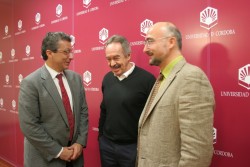 The diagnosis and treatment of neurological illnesses with techniques that do not require intervention and that cause minimal side effects, the opposite to what can happen with pharmacological treatments, today keeps hundreds of researchers busy worldwide. Biologists and neuroscientists who have looked at the human brain, understanding it as a ‘centre of electrical connections’ and not only chemical ones, have found a specific technique, Transcranial Magnetic Stimulation (TMS), to be the perfect ally. It is a technique based on the use of magnetic fields to stimulate or inhibit responses inside the connections (neural networks) of the brain.
The diagnosis and treatment of neurological illnesses with techniques that do not require intervention and that cause minimal side effects, the opposite to what can happen with pharmacological treatments, today keeps hundreds of researchers busy worldwide. Biologists and neuroscientists who have looked at the human brain, understanding it as a ‘centre of electrical connections’ and not only chemical ones, have found a specific technique, Transcranial Magnetic Stimulation (TMS), to be the perfect ally. It is a technique based on the use of magnetic fields to stimulate or inhibit responses inside the connections (neural networks) of the brain.
Two of the scientists who best know the technique and who have achieved the most advances in the knowledge of these illnesses thanks to its use are Harvard neurology professor Álvaro Pascual-Leone and lecturer Réne Drucker-Colín, from the Autonomous University of Mexico. They are both spending these days in Cordoba teaching around fifty Spanish doctors and researchers how to correctly use TMS to advance the treatment of illnesses such as depression or chronic pain, for those who its use is already habitual, or continue advancing in the research of other illnesses such as Parkinson’s disease or epilepsy. TMS, according to the explanation of both experts, has been revealed as an extraordinarily useful tool in the laboratory in which optimum results of cellular differentiation can be achieved without the need to use outdated cultures.
According to Pascual Leone and Drucker-Colín, to guarantee the success of this research, international and multidisciplinary scientific cooperation is absolutely necessary. On this subject, both scientists emphasise the role of physics in the development of the technology used in TMS and the necessity of collaborating with basic and clinical neuroscientists who, from laboratories and health centres, advance knowledge of neurological illnesses every day. For the experts, this teamwork will make possible the extension of the use of TMS to hospitals throughout the world within a few years thanks to the reduction in the cost of technology and the increase in the training of specialists. To achieve this, however, the support of public administrations will be necessary, and these act differently throughout the world. On this point, lecturer Drucker-Colín has stressed the difference between the United States, who apply 2.6% of their GDP to R&D; Spain with 1.1% and Mexico with 0.3%.
Jueves, 22 Diciembre 2016 16:58
Neuroscientists appeal for international collaboration to advance the treatment of neurological illn
Escrito porHarvard neurology professor Álvaro Pascual-Leone and lecturer Réne Drucker-Colín, from the Autonomous University of Mexico, analyse the clinical advantages and research into Transcranial Magnetic Stimulation at the University of Cordoba.
Publicado en
Biomedicina y salud

